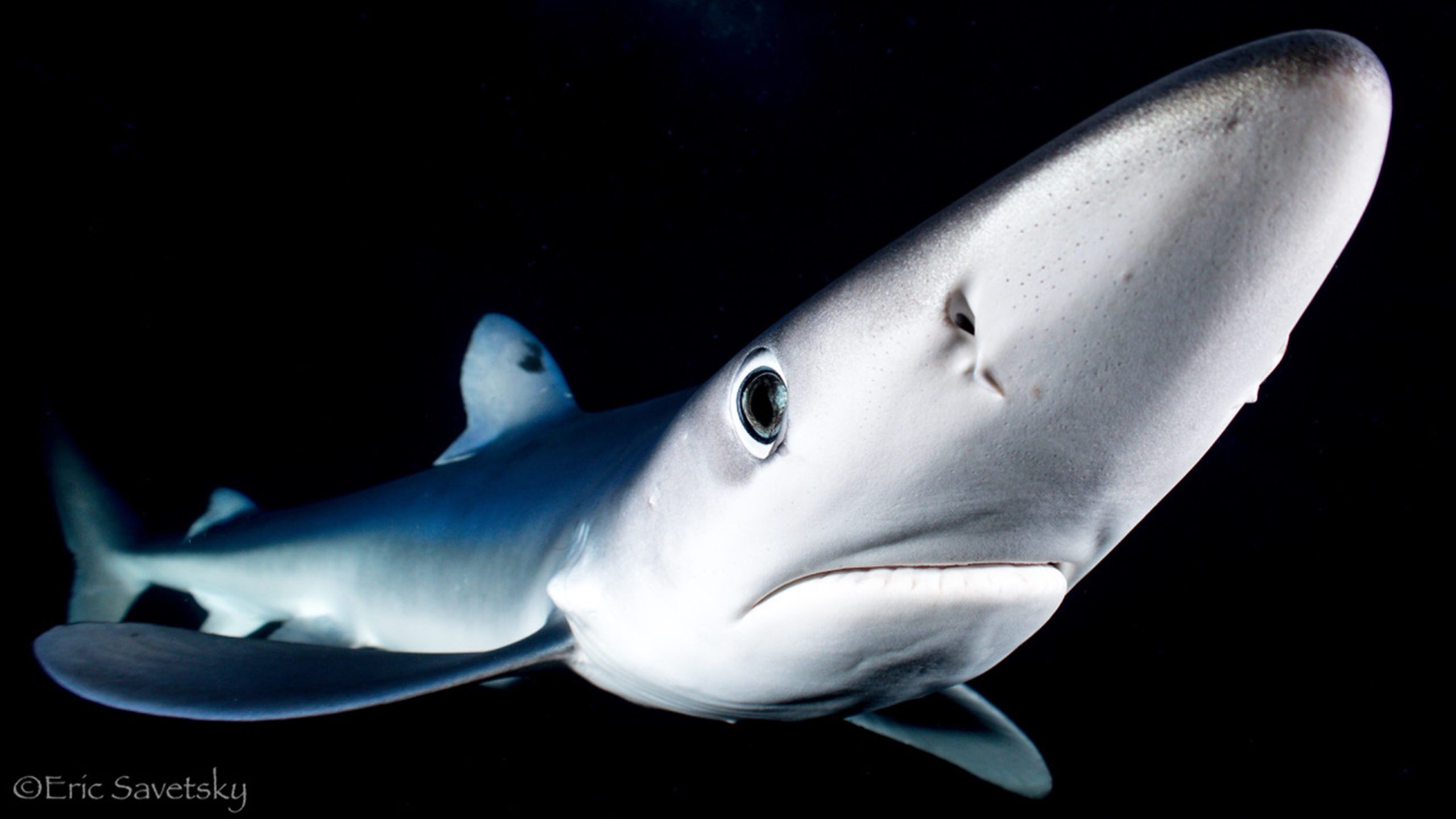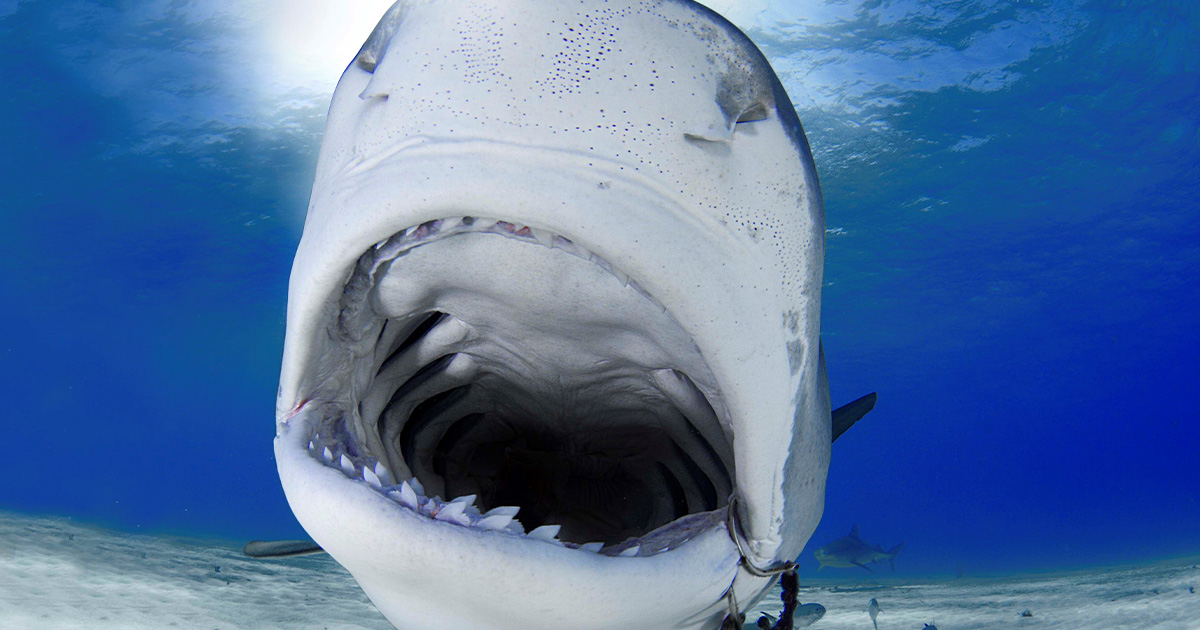If you’ve ever witnessed a shark breach the water—whether in person or somewhere on the Internet—that fleeting but awe-inspiring moment is just a small fraction of the time it spends at the surface of the ocean. Most of the time sharks and other large marine predators are out of sight, begging the question—where do they go?
A new study demonstrates that large predatory fishes like sharks, tunas and billfish make a surprising number of visits to the deep ocean—particularly the mesopelagic zone, which is found between 200 to 1,000 meters below the surface. This area, also called the ocean’s twilight zone, has been overlooked as critical habitat for large predator species, according to the study. The paper is published in the journal Proceedings of the National Academy of Sciences.
Led by Camrin Braun, an assistant scientist at the Woods Hole Oceanographic Institution (WHOI), the study incorporated an astonishing amount of data from multiple scientific partners. He and the co-authors synthesized data from electronic tags, shipboard sonar, Earth-observing satellites, and data-assimilating ocean models to quantify the ecological significance of deep diving for large pelagic predators. They emphasize that a healthy mesopelagic zone provides numerous benefits and ecosystem services to humans as well.
“No matter what top predator you look at, or where you look at them in the global ocean, they all spend time in the deep ocean,” Braun said. “All of these animals that we think of as being residents of the surface ocean, use the deep ocean way more than we previously thought.”
The scientists leveraged data from 344 electronic tags over the course of 46,659 tracking days for 12 species in the North Atlantic Ocean, including white sharks, tiger sharks, whale sharks, Yellowfin tuna, swordfish and more.
 Blue shark off shore Cape Cod. (Image credit: Eric Savetsky)
Blue shark off shore Cape Cod. (Image credit: Eric Savetsky)
The diving patterns of these fish recorded by the tags were then matched with sonar data that showed the daily movements of the deep scattering layer (DSL)—a zone where a huge number of small fish and marine organisms are packed so densely that scientists first using sonar mistook the layer for the ocean floor. During the day, animals in the DSL inhabit the mesopelagic zone. But when the sun sets, many of these individuals—like fish, mollusks, crustaceans, and others—swim to surface waters to feed. When the sun reemerges over the horizon, scattering light over the surface, they descend back to the twilight zone where they will remain until nightfall. This daily rhythm is called Diel Vertical Migration and is a pattern that scientists at WHOI have been studying for decades.
Alice Della Penna, co-author and collaborator at the University of Auckland, New Zealand, who specializes in acoustics, said that it was surprising to see the data sets match so well. “When we looked at this specific process from different perspectives, from the diving and the acoustics together, seeing that everything was falling into place was very exciting.”
After years of collecting and analyzing data, the new paper helps shed light on the predators who are attuned to the DSL, presumably to hunt smaller prey, and the animals who often diverge from the daily vertical migration patterns, leading to further questions about why they are diving so deep, if not to feed.
“Several species aligned perfectly with the expectations that they’re diving to feed, but there are behaviors that aren’t just for feeding,” Braun said. Swordfish for example, follow the Diel Vertical Migration pattern like clockwork. But there are some “really surprising deviations from that behavior,” he explains—"like instead of diving down to 1,500 feet, a swordfish goes to 3,000 or 6,000 feet, much deeper than we would expect for that to be feeding behavior.”
That means they could be diving for other reasons that are not fully understood. Previous work has pointed to these vertical movements maybe serving to avoid predators or aid in navigation, according to the study. Despite the anomalies, all of the large species included in the study interreacted with the mesopelagic organisms in one way or another, finding that it’s worth it for these predators to dive deep into a seemingly inhospitable part of the ocean where there is little light, the pressure is high and temperatures are near freezing.
“Sharks and tunas are evolutionarily a long way apart with very different sensory systems. And yet still both of those groups find that it’s worthwhile to do that type of behavior,” said Simon Thorrold, fish ecologist at WHOI and co-author on the study. With the large number of fish and organisms making this trek, Thorrold said that these species are potentially moving a hefty amount of carbon dioxide from the surface into the deep ocean where it will stay for centuries—a potentially significant ecosystem service of the mesopelagic that is not yet quantified.
Since the twilight zone is clearly important to many large species that are fished commercially, “this deep-sea biomass contributes ecosystem services that are worth a considerable amount of money,” Thorrold, said. The paper stresses that it is in everyone’s interest to keep the mesopelagic intact, and that it is important to study these deep ocean food webs further before fishing or extracting activities occur. The paper states that “the overlap in ongoing fishing effort and pelagic predator distributions, expected climate-induced changes in pelagic ecosystems and the potential extraction of mesopelagic biomass,” can put this critical ecosystem in jeopardy.
“We're finding that the mesopelagic is providing an important support for other parts of the ocean,” Della Penna said. “If we start to exploit these mesopelagic ecosystems before we know how they work, there's a really big risk of causing damage that is not easily reversible.”
Funding for this research was provided by The Coastal Research Fund in Support of Scientific Staff and the Investment in Science Fund at the Woods Hole Oceanographic Institution (to CDB), the WHOI President’s Innovation Fund and Postdoctoral Scholar Program at Woods Hole Oceanographic Institution with funding provided by the Dr. George D. Grice Postdoctoral Scholarship Fund (to MCA), UK Natural Environment Research Council (to DWS), the European Research Council (to DWS), a Marine Biological Association Senior Research Fellowship (to DWS) and the King Abdullah University of Science and Technology (baseline research funds to MLB). BCLM was supported by the projects IslandShark (PTDC/BIA-BMA/32204/2017), AEROS-Az (ACORES-01-0145-FEDER-000131), MEESO (EU H2020-LC-BG-03-2018), and Mission Atlantic (H2020-LC-BG-08-2018-862428). This work was part of the Woods Hole Oceanographic Institution’s Ocean Twilight Zone Project, funded as part of the Audacious Project housed at TED.



